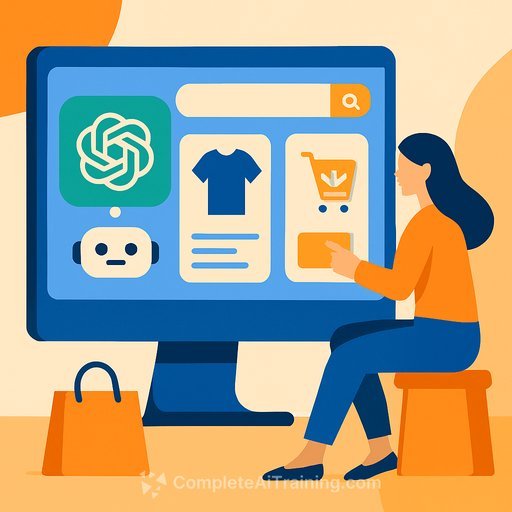ChatGPT traffic is growing in ecommerce, but it still trails core digital channels
A new large-scale study of 973 ecommerce sites shows referrals from ChatGPT and other LLMs are gaining momentum, but they lag behind established channels on sales outcomes. The dataset covered August 2024 to July 2025, spanning $20B in annual revenue, with 50,000+ LLM-referred transactions versus 164M from traditional sources.
Bottom line: organic LLM (oLLM) traffic underperformed every traditional channel except paid social on conversion rate, average order value, and revenue per session. Bounce rates were lower for ChatGPT traffic, which signals relevance, but fewer users completed purchases and revenue trailed both paid and organic search.
What the data says
- Scale: 973 sites, $20B combined revenue, 12 months of data, 50K+ oLLM transactions, 164M from traditional channels.
- Performance: oLLM trails organic search, paid search, email, and organic social on conversion, AOV, and revenue per session. It outperforms only paid social.
- Quality signal: Lower bounce rates from ChatGPT referrals, but weaker purchase completion and revenue than Google traffic.
- Trend: oLLM conversion rates improved over the year; declining AOV muted gains. Projections show no parity with organic search within the next year.
- Robustness: Results held across multiple data checks. oLLM is a developing channel, not a replacement for core search.
Why this matters for sales leaders
ChatGPT is starting to influence discovery and engagement, but it isn't a primary revenue driver yet. Treat it like an emerging assist channel. Keep search as your workhorse and use oLLM to open doors, collect interest, and feed remarketing and outbound plays.
The upside: intent from LLM referrals is real. The gap is conversion and order value. Your job is to bridge that with better mid-funnel offers, cleaner product data, and targeted follow-up.
Practical playbook: turn LLM interest into revenue
- Segment oLLM traffic in analytics. Use distinct source/medium tags for ChatGPT and other LLMs. Track conversion rate, AOV, revenue per session, and assisted conversions.
- Ship LLM-ready content. Create clear FAQs, comparison pages, and product summaries that answer common prompts. Make specs, pricing, and availability explicit.
- Use structured data to improve how content is summarized and referenced in AI systems. Start with core schemas for products, ratings, and FAQs. Structured data guide
- Build low-friction offers for mid-funnel visitors: quick-quote, quiz-to-recommendation, or ROI calculator. LLM traffic often needs a step before checkout.
- Create landing pages tailored to the prompt context. If users arrive from "best X for Y" queries, lead with the comparison, then a clear next step.
- Tighten follow-up. Capture email with a compelling micro-offer and enroll in a short, value-first sequence. Coordinate remarketing to bring them back via search or email.
- Guard the budget. Keep the majority in organic and paid search while allocating a small, measurable test budget (5-10% of experimental spend) to oLLM pilots.
- Set rules. Scale if oLLM hits predefined thresholds for CR and RPS over 4-6 weeks; pause if it lags after two iterations of landing page and offer testing.
Metrics to watch
- Conversion rate trend for oLLM vs. your site average
- Average order value and revenue per session
- Assisted conversions and time-to-purchase
- Engagement depth: bounce rate, scroll, and key actions (add-to-cart, demo request, quote start)
Budget and timeline guidance
Don't bet the quarter on LLM referrals. Keep your foundation in organic and paid search, which continue to outperform on revenue. Use oLLM to widen the top and middle of the funnel and convert with proven channels.
Expect gradual gains over the next year, not a flip. LLMs aren't replacing Google anytime soon, but they're becoming a real discovery touchpoint. Treat it like any new source: test, instrument, iterate, and scale only when the numbers back it up.
Next steps for your team
- Tag and track oLLM traffic this week.
- Publish one prompt-ready comparison page and one FAQ-driven product page.
- Launch a mid-funnel lead offer tied to your highest-margin product line.
- Review performance after two sprints and reallocate budget accordingly.
Want structured training on AI plays that actually move pipeline? Explore role-based paths here: AI courses by job
Your membership also unlocks:






